Evaluating Effects of Poultry Waste Application on Phosphorus Loads to Lake Tenkiller
Abstract
:1. Introduction
2. Materials and Methods
2.1. Study Area
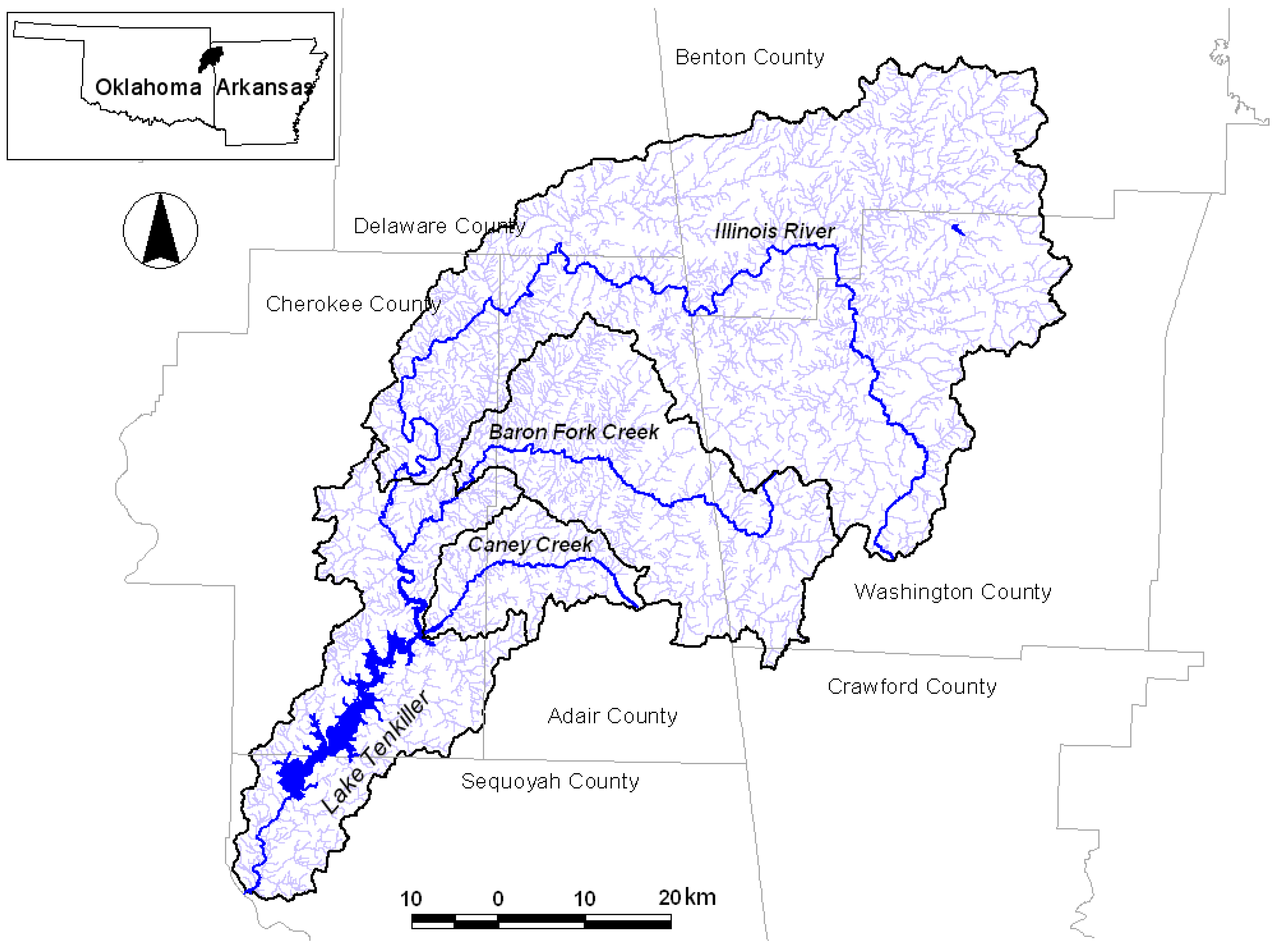
2.2. Data Preparation
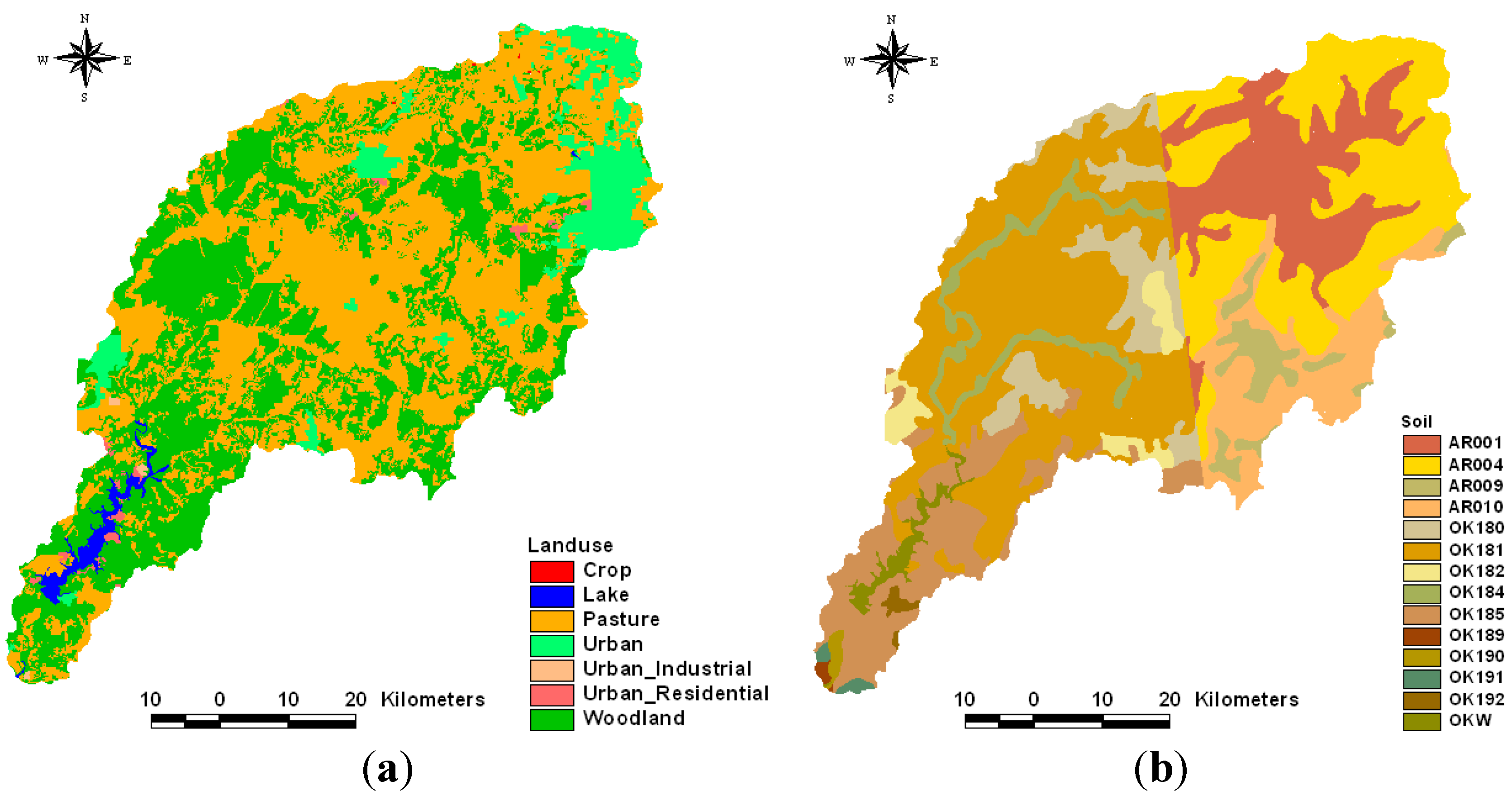
| Watershed Name | USGS Gage Station |
|---|---|
| Illinois River at Tahlequah | USGS 07196500 Illinois River near Tahlequah, OK |
| Baron Fork | USGS 07197000 Baron Fork at Eldon, OK |
| Caney Creek | USGS 07197360 Caney Creek near Barber, OK |
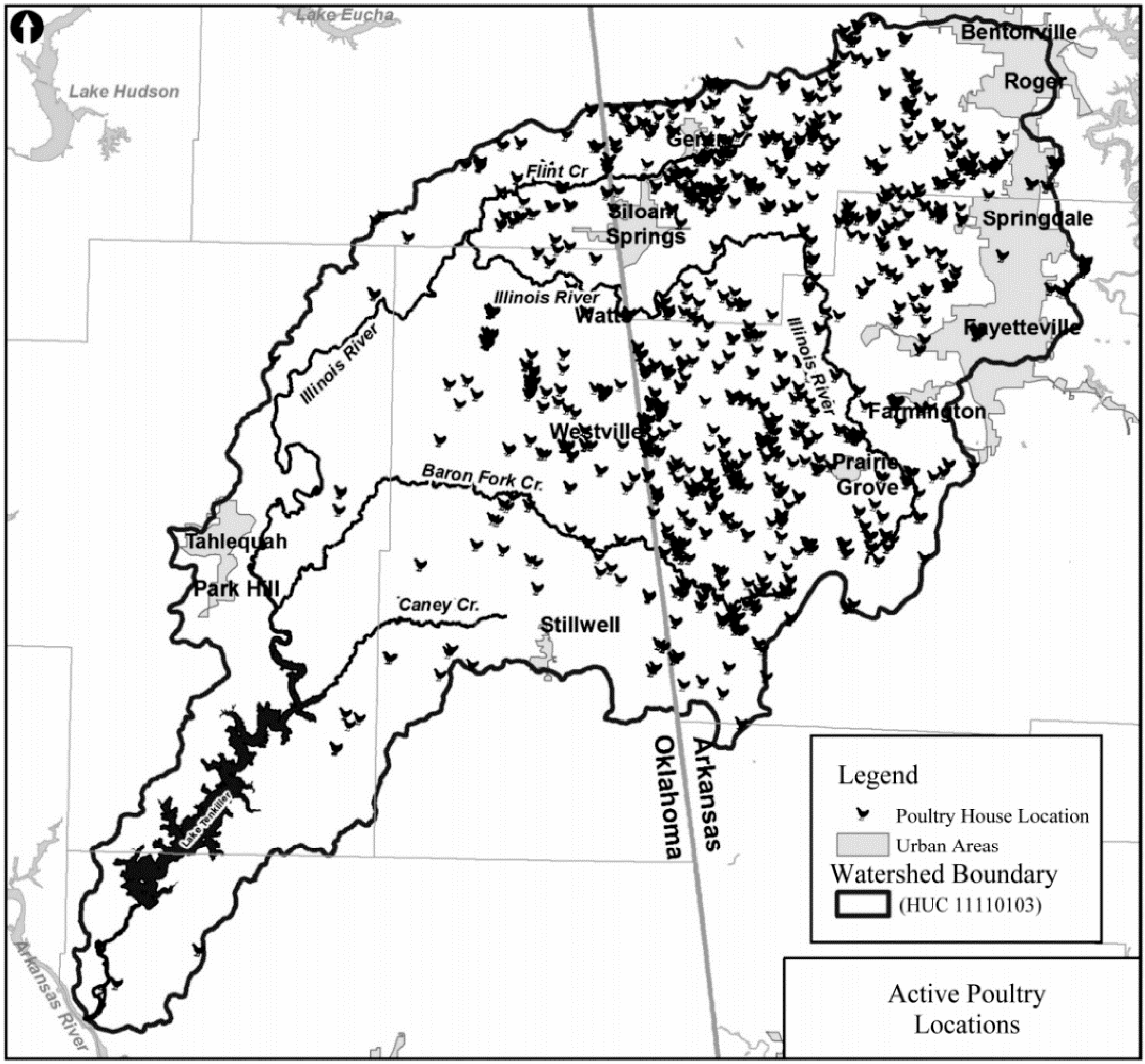
| Item | Relative Error (%) | ||
|---|---|---|---|
| Very Good | Good | Fair | |
| Hydrology/Flow | <10 | 10–15 | 15–25 |
| Sediment | <20 | 20–30 | 30–45 |
| Water Temperature | <7 | 8–12 | 13–18 |
| Water Quality/Nutrients | <15 | 15–25 | 25–35 |
| Pesticides/Toxics | <20 | 20–30 | 30–40 |
2.3. GLEAMS Application
2.4. Scenario Development
| Name | Description |
|---|---|
| Scenario 1 | Continued poultry waste application to pastures at present rates |
| Scenario 2 | Cessation of poultry waste application |
| Scenario 3 | Growth in IRW poultry numbers based on 1982 to 2002 growth and corresponding waste application |
| Scenario 4 | Cessation of poultry waste application combined with buffers along streams |
3. Results and Discussion
3.1. GLEAMS Calibration and Validation

| Watersheds | Calibration | Validation | ||||||
|---|---|---|---|---|---|---|---|---|
| NS | R2 | RE | Performance | NS | R2 | RE | Performance | |
| Baron Fork | 0.64 | 0.65 | 6 | Very good | 0.73 | 0.73 | −5 | Very good |
| Illinois River at Tahlequah | 0.63 | 0.68 | −20 | Fair | 0.59 | 0.67 | −27 | Fair |
| Caney Creek | 0.51 | 0.60 | 8 | Very good | Data is not available | |||
| Year | Modeled P Load | Observed Total P Load | |||
|---|---|---|---|---|---|
| Illinois River at Tahlequah | Baron Fork | Caney Creek | Total | ||
| 1997 | 126,532 | 28,029 | 9922 | 164,483 | 109,364 |
| 1998 | 184,348 | 39,941 | 6877 | 231,165 | 214,013 |
| 1999 | 195,315 | 24,103 | 3545 | 222,963 | 204,316 |
| 2000 | 289,965 | 118,355 | 19,040 | 427,361 | 510,540 |
| 2001 | 175,444 | 33,119 | 11,954 | 220,517 | 268,751 |
| 2002 | 115,266 | 22,789 | 4813 | 142,869 | 168,153 |
| 2003 | 54,647 | 2894 | 1358 | 58,899 | 49,113 |
| 2004 | 304,970 | 123,250 | 26,674 | 454,894 | 520,696 |
| 2005 | 151,136 | 26,684 | 5780 | 183,600 | 154,523 |
| 2006 | 70,427 | 21,685 | 5004 | 97,115 | 89,489 |
| Average | 166,805 | 44,085 | 9497 | 220,387 | 228,896 |
| Calibration/Validation | Average yearly P Load (kg) | Relative Error | Performance | |
|---|---|---|---|---|
| Observation | Simulation | |||
| Calibration (2002~2006) | 261,398 | 253,298 | −3% | Very good |
| Validation (1997~2001) | 196,395 | 187,476 | −5% | Very good |

3.2. Historical P Loads in Illinois River Watershed Streams and Rivers
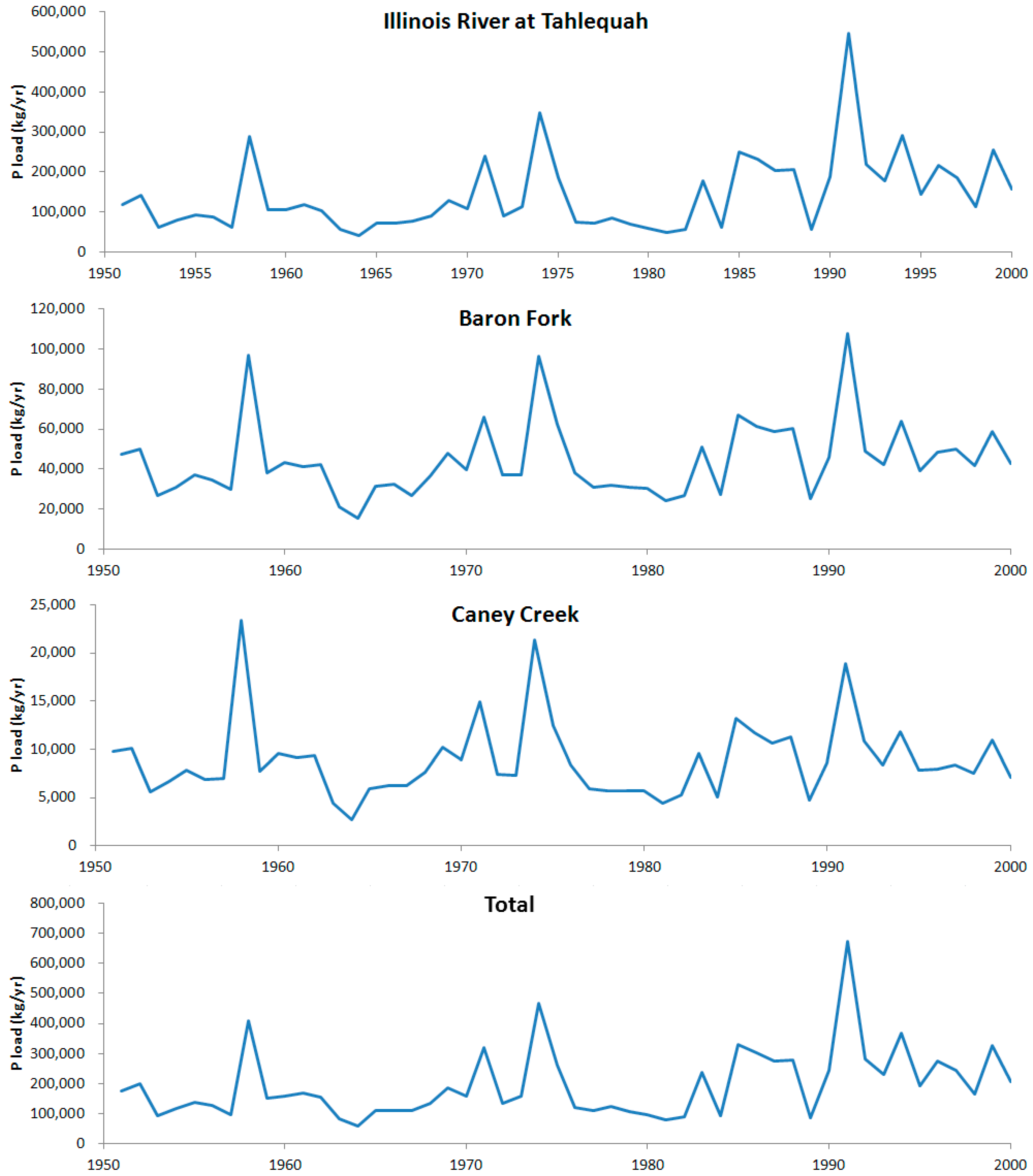
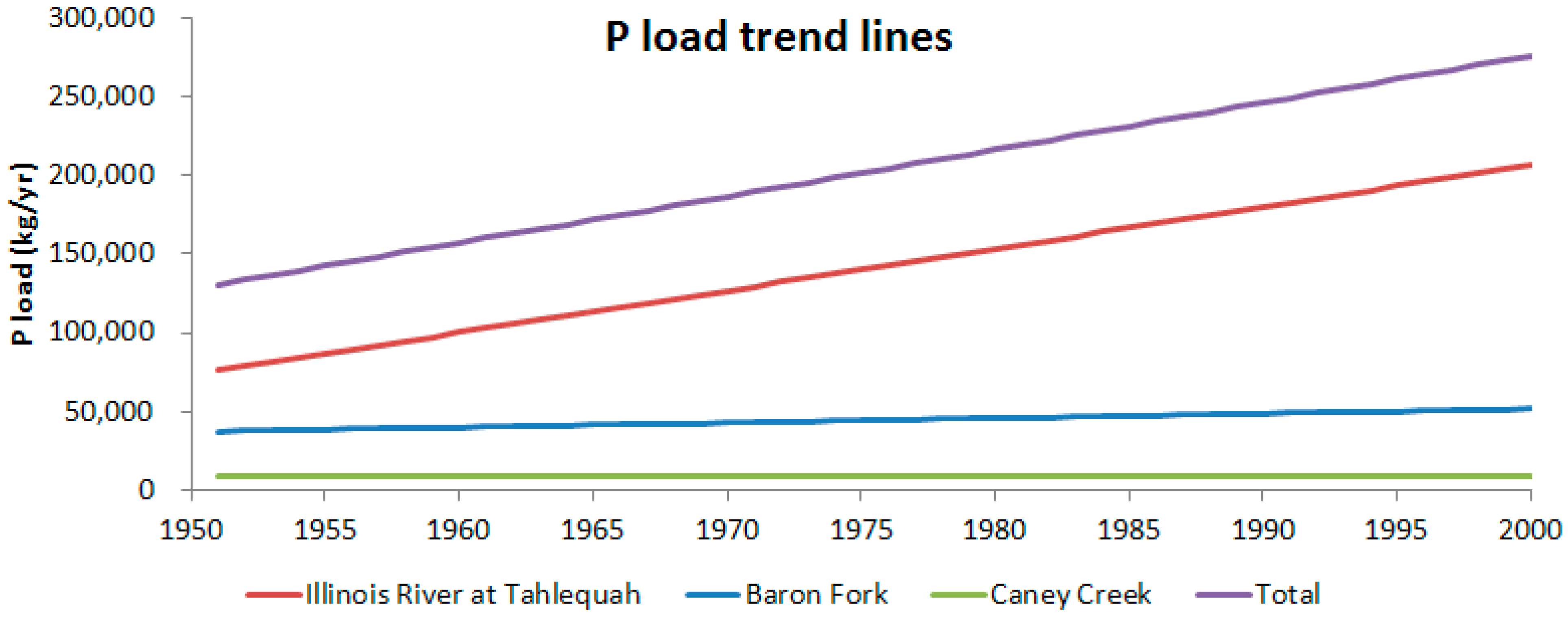
| Year | Modeled P Load (kg/year) | |||
|---|---|---|---|---|
| Illinois River at Tahlequah | Baron Fork | Caney Creek | Total | |
| 1951–1960 | 113,774 | 43,483 | 9449 | 166,706 |
| 1961–1970 | 87,168 | 33,484 | 7084 | 127,737 |
| 1971–1980 | 134,047 | 46,190 | 9462 | 189,699 |
| 1981–1990 | 148,800 | 44,685 | 8452 | 201,937 |
| 1991–2000 | 231,138 | 54,308 | 9961 | 295,406 |
| Average | 142,985 | 44,430 | 8882 | 196,297 |
3.3. Scenario Evaluation
3.3.1. Increased Poultry Waste Application
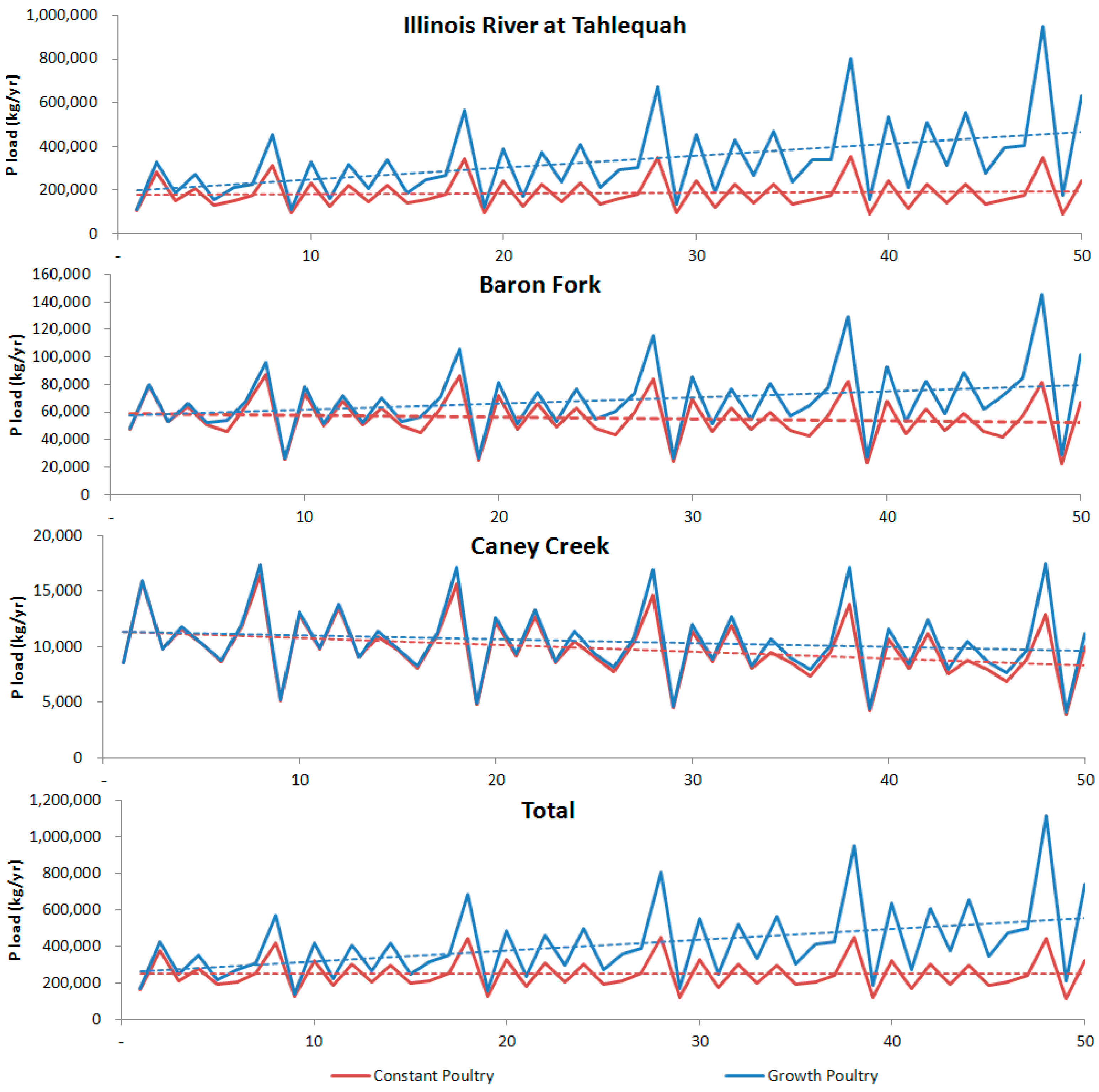
| Watershed | Year | |||||
|---|---|---|---|---|---|---|
| 1–10 | 11–20 | 21–30 | 31–40 | 41–50 | ||
| Illinois River at Tahlequah | Growth poultry | 237,890 | 279,284 | 325,687 | 376,016 | 441,186 |
| Constant poultry | 183,980 | 187,244 | 188,962 | 186,635 | 185,381 | |
| Difference (%) | 29 | 49 | 72 | 101 | 138 | |
| Barron Fork | Growth poultry | 62,307 | 64,056 | 67,171 | 71,170 | 77,729 |
| Constant poultry | 59,291 | 57,245 | 55,561 | 53,681 | 52,877 | |
| Difference (%) | 5 | 12 | 21 | 33 | 47 | |
| Caney Creek | Growth poultry | 11,265 | 10,827 | 10,460 | 10,064 | 9805 |
| Constant poultry | 11,100 | 10,481 | 9878 | 9224 | 8609 | |
| Difference (%) | 1 | 3 | 6 | 9 | 14 | |
| Total | Growth poultry | 311,462 | 354,167 | 403,318 | 457,250 | 528,720 |
| Constant poultry | 254,371 | 254,969 | 254,401 | 249,540 | 246,868 | |
| Difference (%) | 22 | 39 | 59 | 83 | 114 | |
3.3.2. Poultry Waste Cessation
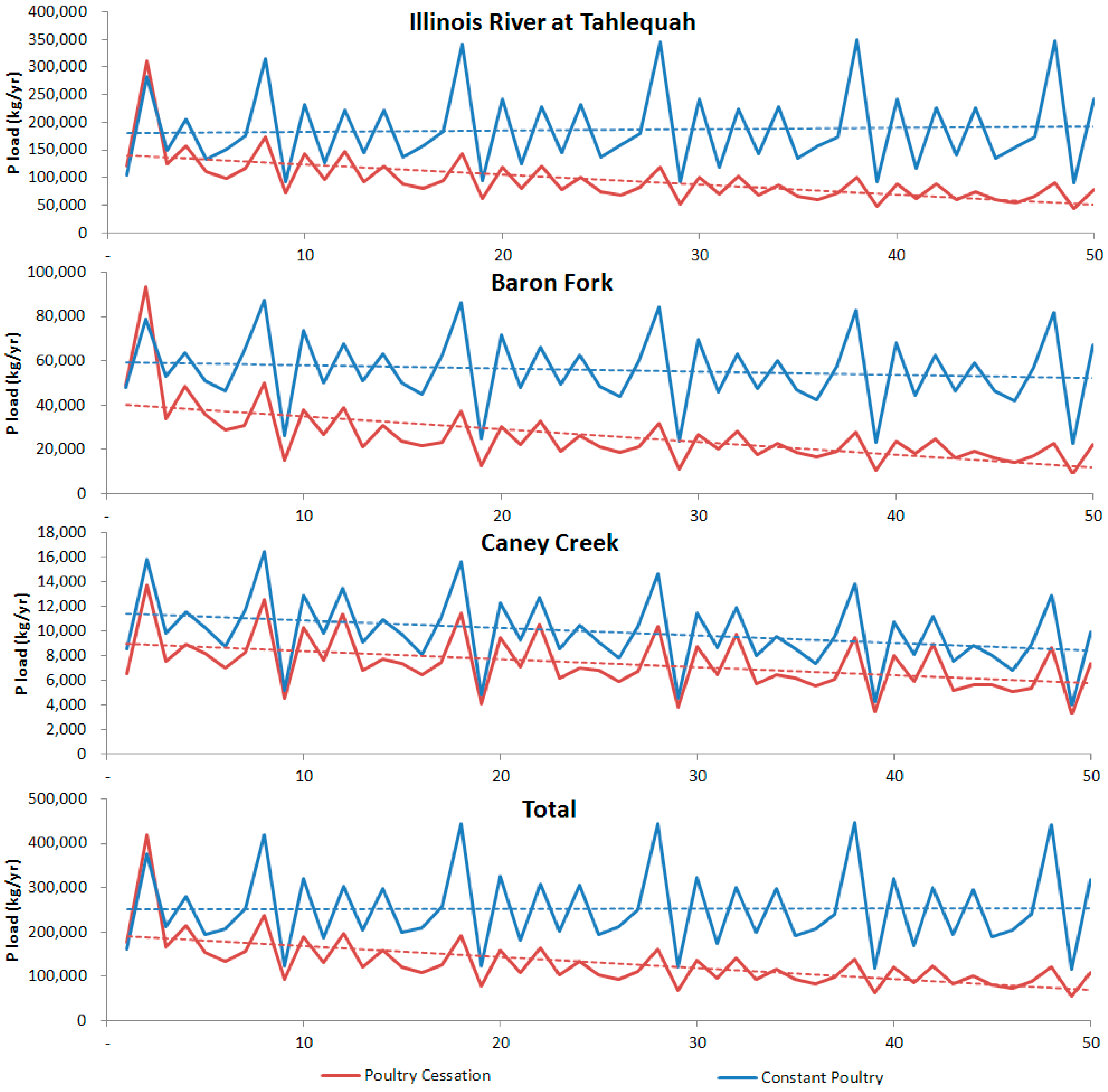
| Watershed | Year | |||||
|---|---|---|---|---|---|---|
| 1–10 | 11–20 | 21–30 | 31–40 | 41–50 | ||
| Illinois River at Tahlequah | Constant poultry | 183,980 | 187,244 | 188,962 | 186,635 | 185,381 |
| Poultry cessation | 142,965 | 104,696 | 87,721 | 76,732 | 67,958 | |
| Difference (%) | −22 | −44 | −54 | −59 | −63 | |
| Barron Fork | Constant poultry | 59,291 | 57,245 | 55,561 | 53,681 | 52,877 |
| Poultry cessation | 42,200 | 26,556 | 22,991 | 20,414 | 17,814 | |
| Difference (%) | −29 | −54 | −59 | −62 | −66 | |
| Caney Creek | Constant poultry | 11,100 | 10,481 | 9878 | 9224 | 8609 |
| Poultry cessation | 8733 | 7,975 | 7,312 | 6,693 | 6089 | |
| Difference (%) | −21 | −24 | −26 | −27 | −29 | |
| Total | Constant poultry | 254,371 | 254,969 | 254,401 | 249,540 | 246,868 |
| Poultry cessation | 193,898 | 139,227 | 118,023 | 103,839 | 91,861 | |
| Difference (%) | −24 | −45 | −54 | −58 | −63 | |
3.3.3. Buffers and Poultry Waste Land Application Cessation
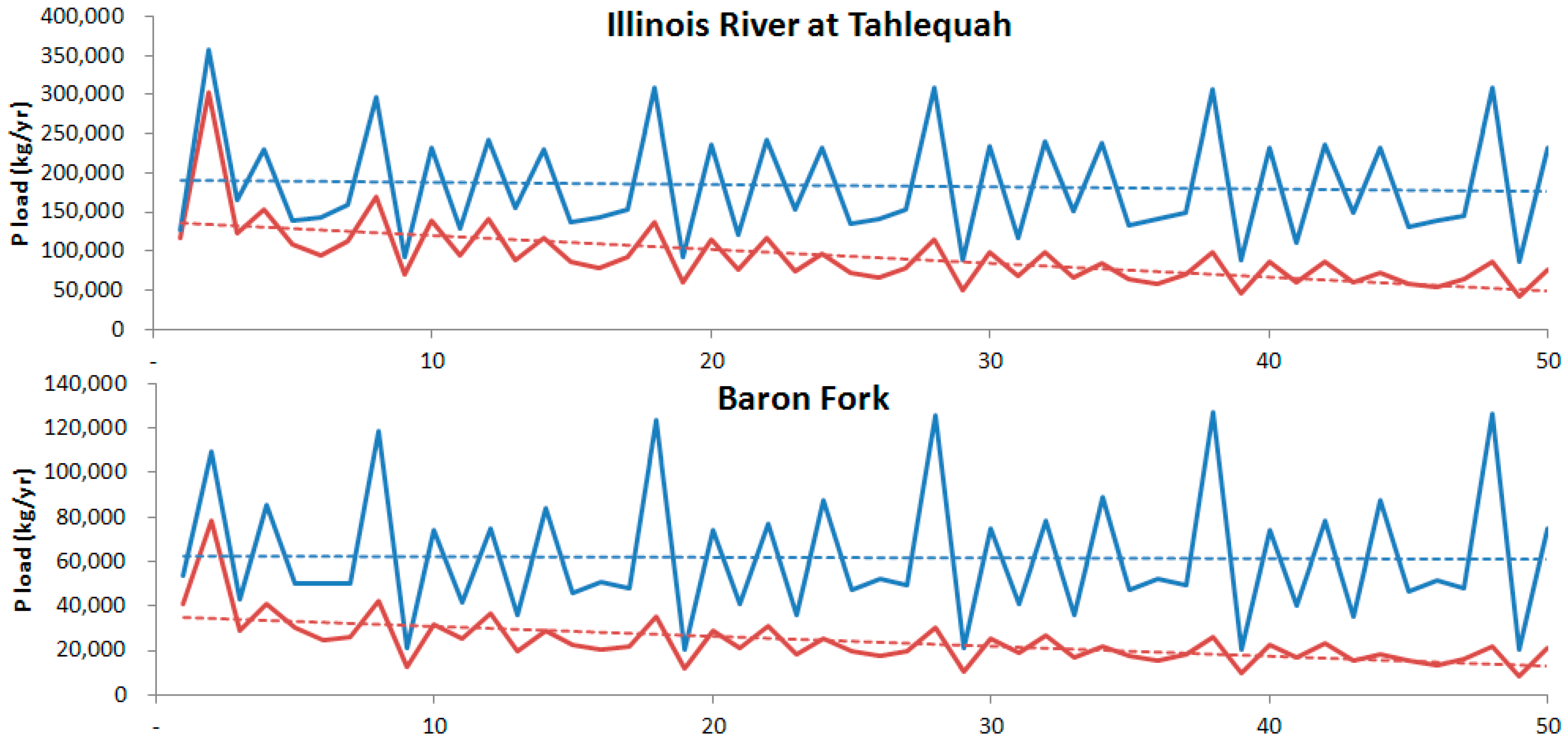
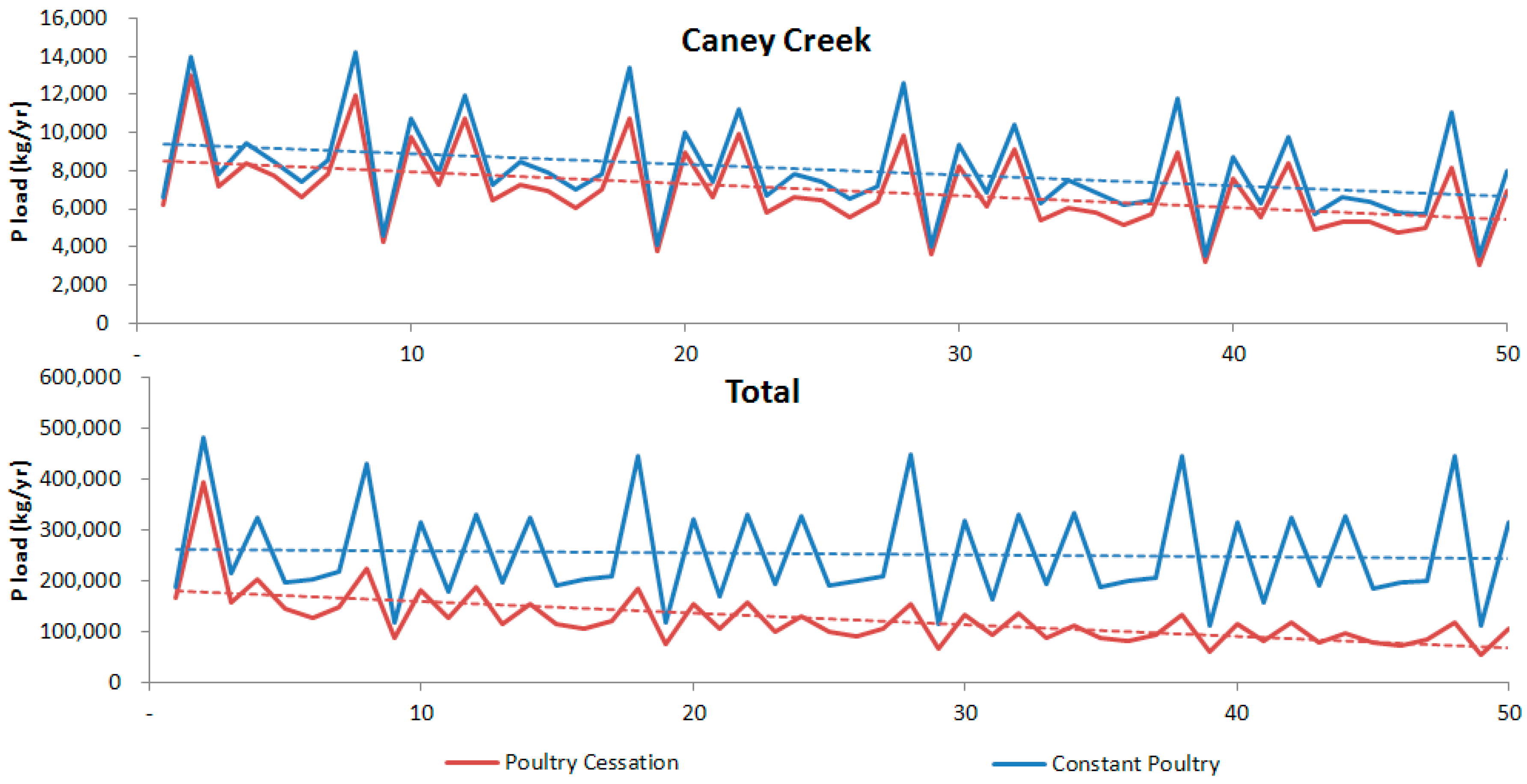
| Watershed | Year | |||||
|---|---|---|---|---|---|---|
| 1–10 | 11–20 | 21–30 | 31–40 | 41–50 | ||
| Illinois River at Tahlequah | Constant poultry | 183,980 | 187,244 | 188,962 | 186,635 | 185,381 |
| Poultry cessation + buffer | 139,248 | 101,013 | 84,745 | 74,272 | 65,885 | |
| Difference (%) | −24 | −46 | −55 | −60 | −64 | |
| Barron Fork | Constant poultry | 59,291 | 57,245 | 55,561 | 53,681 | 52,877 |
| Poultry cessation + buffer | 35,647 | 25,109 | 21,839 | 19,400 | 16,931 | |
| Difference (%) | −40 | −56 | −61 | −64 | −68 | |
| Caney Creek | Constant poultry | 11,100 | 10,481 | 9878 | 9224 | 8609 |
| Poultry cessation + buffer | 8288 | 7,525 | 6901 | 6319 | 5750 | |
| Difference (%) | −25 | −28 | −30 | −31 | −33 | |
| Total | Constant poultry | 254,371 | 254,969 | 254,401 | 249540 | 246,868 |
| Poultry cessation + buffer | 183,183 | 133,647 | 113,485 | 99,990 | 88,566 | |
| Difference (%) | −28 | −48 | −55 | −60 | −64 | |
4. Conclusions
Acknowledgments
Author Contributions
Conflicts of Interest
References
- Vollenweider, R.A. The Scientific Basis of Lake and Stream Eutrophication with Particular Reference to Phosphorus and Nitrogen as Eutrophication Factors; Tech. Rep. DAS/DSI/68.27; Organization for Economic Cooperation and Development: Paris, France, 1968. [Google Scholar]
- Dillon, P.J.; Rigler, F.H. The phosphorus-chlorophyll relationship in lakes. Limnol. Oceanogr. 1974, 19, 767–773. [Google Scholar] [CrossRef]
- Prepas, E.E.; Trew, D.O. Evaluation of the phosphorus-chlorophyll relationship for lakes off the Precambrian Shield in Western Canada. Can. J. Fish. Aquat. Sci. 1983, 40, 27–35. [Google Scholar] [CrossRef]
- Mazumder, A. Phosphorus-chlorophyll relationships under contrasting herbivory and thermal stratification: Predictions and patterns. Can. J. Fish. Aquat. Sci. 1994, 51, 390–400. [Google Scholar] [CrossRef]
- Conroy, J.D.; Kane, D.D.; Dolan, D.M.; Edwards, W.J.; Charlton, M.N.; Culver, D.A. Temporal trends in Lake Erie plankton biomass: Roles of external phosphorus loading and dreissenid mussels. J. Great Lakes Res. 2005, 1, 89–110. [Google Scholar] [CrossRef]
- Cook, P.L.; Holland, D.P. Long term nutrient loads and chlorophyll dynamics in a large temperate Australian lagoon system affected by recurring blooms of cyanobacteria. Biogeochemistry 2012, 107, 261–274. [Google Scholar] [CrossRef]
- Sharpley, A.N.; Herron, S.; Daniel, T. Overcoming the challenges of phosphorus based management in poultry farming. J. Soil Water Conserv. 2007, 62, 375–389. [Google Scholar]
- Kellogg, R.L.; Lander, C.H.; Moffitt, D.C.; Gollehon, N. Manure nutrients relative to the capacity of cropland and pastureland to assimilate nutrients: Spatial and temporal trends for the United States. Proc. Water Environ. Fed. 2000, 16, 18–157. [Google Scholar] [CrossRef]
- Kleinman, P.J.; Sharpley, A.N.; Wolf, A.M.; Beegle, D.B.; Moore, P.A. Measuring water-extractable phosphorus in manure as an indicator of phosphorus in runoff. Soil Sci. Soc. Am. J. 2002, 66, 2009–2015. [Google Scholar] [CrossRef]
- Dutta, S.; Inamdar, S.; Tso, J.; Aga, D.S.; Sims, J.T. Free and conjugated estrogen exports in surface-runoff from poultry litter-amended soil. J. Environ. Qual. 2010, 39, 1688–1698. [Google Scholar] [CrossRef] [PubMed]
- Romeis, J.; Hellmich, R.L.; Candolfi, M.P.; Carstens, K.; de Schrijver, A.; Gatehouse, A.M.R.; Herman, R.A.; Huesting, J.E.; McLean, M.A.; Raybould, A.; et al. Recommendations for the design of laboratory studies on non-target arthropods for risk assessment of genetically engineered plants. Transgenic Res. 2011, 20, 1–22. [Google Scholar] [CrossRef] [PubMed]
- Abdala, D.B.; Ghosh, A.K.; da Silva, I.R.; de Novais, R.F.; Alvarez Venegas, V.H. Phosphorus saturation of a tropical soil and related P leaching caused by poultry litter addition. Agric. Ecosyst. Environ. 2012, 162, 15–23. [Google Scholar] [CrossRef]
- Reiter, M.S.; Daniel, T.C.; DeLaune, P.B.; Sharpley, A.N.; Lory, J.A. Effects of long-term poultry litter application on phosphorus soil chemistry and runoff water quality. J. Environ. Qual. 2013, 42, 1829–1837. [Google Scholar] [CrossRef] [PubMed]
- Ranatunga, T.D.; Reddy, S.S.; Taylor, R.W. Phosphorus distribution in soil aggregate size fractions in a poultry litter applied soil and potential environmental impacts. Geoderma 2013, 192, 446–452. [Google Scholar] [CrossRef]
- Cox, T.J.; Engel, B.A.; Olsen, R.L.; Fisher, J.B.; Santini, A.D.; Bennett, B.J. Relationships between stream phosphorus concentrations and drainage basin characteristics in a watershed with poultry farming. Nutr. Cycl. Agroecosyst. 2013, 95, 353–364. [Google Scholar] [CrossRef]
- Adams, P.L.; Daniel, T.C.; Nichols, D.J.; Pote, D.H.; Scott, H.D.; Edwards, D.R. Poultry litter and manure contributions to nitrate leaching through the vadose zone. Soil Sci. Soc. Am. J. 1994, 58, 1206–1211. [Google Scholar] [CrossRef]
- Kang, M.S.; Srivastava, P.; Tyson, T.; Fulton, J.P.; Owsley, W.F.; Yoo, K.H. A comprehensive GIS-based poultry litter management system for nutrient management planning and litter transportation. Comput. Electron. Agric. 2008, 64, 212–224. [Google Scholar] [CrossRef]
- DeLaune, P.B.; Haggard, B.E.; Daniel, T.C.; Chaubey, I.; Cocharn, M.J. The Eucha/Spavinaw phosphorus index: A court mandated index for litter management. J. Soil Water Conserv. 2006, 61, 96–105. [Google Scholar]
- Bosch, D.J.; Wolfe, M.L.; Knowlton, K.E. Reducing phosphorus runoff from dairy farms. J. Environ. Qual. 2006, 35, 918–927. [Google Scholar] [CrossRef] [PubMed]
- Sims, J.T.; Luka-McCafferty, N.J. On-farm evaluation of aluminum sulfate (alum) as a poultry litter amendment. J. Environ. Qual. 2002, 31, 2066–2073. [Google Scholar] [CrossRef] [PubMed]
- Seiter, J.M.; Staats-Borda, K.E.; Ginder-Vogel, M.; Sparks, D.L. XANES spectroscopic analysis of phosphorus speciation in alum-amended poultry litter. J. Environ. 2008, 37, 477–485. [Google Scholar] [CrossRef] [PubMed]
- Smith, D.R.; Moore, P.A.; Miles, D.M.; Haggard, B.E.; Daniel, T.C. Decreasing phosphorus runoff losses from land-applied poultry litter with dietary modifications and alum addition. J. Environ. Qual. 2004, 33, 2210–2216. [Google Scholar] [CrossRef] [PubMed]
- Watts, D.B.; Torbert, H.A. Impact of gypsum applied to grass buffer strips on reducing soluble P in surface water runoff. J. Environ. Qual. 2009, 38, 1511–1517. [Google Scholar] [CrossRef] [PubMed]
- Chaubey, I.; Chiang, L.; Gitau, M.W.; Mohamed, S. Effectiveness of best management practices in improving water quality in a pasture-dominated watershed. J. Soil Water Conserv. 2010, 65, 424–437. [Google Scholar] [CrossRef]
- Knisel, W.G.; Turtola, E. GLEAMS model application on a heavy clay soil in Finland. Agric. Water Manag. 2000, 43, 285–309. [Google Scholar] [CrossRef]
- De Paz, J.M.; Ramos, C. Simulation of nitrate leaching for different nitrogen fertilization rates in a region of Valencia (Spain) using a GIS–GLEAMS system. Agr. Ecosyst. Environ. 2004, 103, 59–73. [Google Scholar] [CrossRef]
- Bakhsh, A.; Kanwar, R.S.; Jaynes, D.B.; Colvin, T.S.; Ahuja, L.R. Prediction of NO3-N losses with subsurface drainage water from manured and UAN-fertilized plots using GLEASM. Trans. ASAE 1999, 43, 69–77. [Google Scholar] [CrossRef]
- Adeuya, R.K.; Lim, K.J.; Engel, B.A.; Thomas, M.A. Modeling the average annual nutrient losses of two watersheds in Indiana using GLEAMS-NAPRA. Trans. ASAE 2005, 48, 1739–1749. [Google Scholar] [CrossRef]
- Cooke, G.D.; Welch, E.B.; Jones, J.R. Eutrophication of Tenkiller Reservoir, Oklahoma, from nonpoint agricultural runoff. Lake Reserv. Manag. 2011, 27, 256–270. [Google Scholar] [CrossRef]
- OSRC (Oklahoma Scenic Rivers Commission). The Illinois River Management Plan—1999; Oklahoma Scenic River Commisson: Tahlequah, OK, USA, 1998. [Google Scholar]
- Haraughty, S. Comprehensive Basin Management Plan for the Illinois River Basin in Oklahoma; Oklahoma Conservation Commission: Tahlequah, OK, USA, 1999. [Google Scholar]
- Olsen, R.L.; Chappell, R.W.; Loftis, J.C. Water Quaty Sample Collection, Data Treatment and Results Presentation for Principal Components Analysis: Literature Review and Illinois River Watershed Case Study. Water Res. 2012, 46, 3110–3122. [Google Scholar] [CrossRef] [PubMed]
- Engel, B.A.; Smith, M.; Fisher, J.B.; Olsen, R.; Ahiablame, L. Phosphorus Mass Balance of the Illinois River Watershed in Arkansas and Oklahoma. J. Water Resour. Prot. 2013, 5, 591–603. [Google Scholar] [CrossRef]
- Pickup, B.E.; Andrews, W.J.; Haggard, B.E.; Green, W.R. Phosphorus Concentrations, Loads and Yields in the Illinois River Basin, Arkansas and Oklahoma, 1977–2001; US Geological Survey Water Resources Investigations Report 03-4168; USGS: Reston, VA, USA, 2003.
- Fisher, J.B.; Hight, R.; van Waasbergen, R.; Engel, B.A.; Smith, M. Estimates of the Mass Generated, Disposal Timing and the Spatial Distribution of Disposal Sites within the Illinois River Watershed (Oklahoma and Arkansas, United States). In Proceedings of the 20th International Symposium on Environmental Science and Technology, Shanghai, China, 2–5 June 2009; pp. 1238–1247.
- Veneman, A.M.; Jen, J.J. 2002 Census of Agriculture; United States Summary and State Data, Vol. 1, Geographic Area Series Part 51, AC-02-A-51; USDA: Washington, DC, USA, 2004.
- USGS Water Resources Applications Software: LOADEST. Available online: http://water.usgs.gov/software/loadest (accessed on 3 October 2014).
- Arnold, J.G.; Srinivasan, R.; Muttiah, R.S.; Williams, J.R. Large area hydrologic modeling and assessment part I: Model development. J. Am. Water Resour. Assoc. JAWRA 1998, 34, 73–89. [Google Scholar] [CrossRef]
- De Paz, J.M.; Ramos, C. Linkage of a geographical information system with the gleams model to assess nitrate leaching in agricultural areas. Environ. Pollut. 2002, 118, 249–258. [Google Scholar]
- Leone, A.; Ripa, M.N.; Uricchio, V.; Deák, J.; Vargay, Z. Vulnerability and risk evaluation of agricultural nitrogen pollution for Hungary’s main aquifer using DRASTIC and GLEAMS model. J. Environ. Manag. 2009, 90, 2969–2978. [Google Scholar] [CrossRef] [PubMed]
- Manguerra, H.B.; Tate, W.; Lahlou, M. ARCVIEW-GLEAMS Integration for Pesticide Source Loading Estimation; Parsons, J.E., Thomas, D.L., Huffman, R.L., Eds.; Southern Cooperative Series Bulletin: Oklahoma City, OK, USA, 2001; pp. 169–183. [Google Scholar]
- Garnier, M.; Lo Porto, A.; Marini, R.; Leone, A. Integrated use of GLEAMS and GIS to prevent groundwater pollution caused by agricultural disposal of animal waste. Environ. Manag. 1998, 22, 747–756. [Google Scholar] [CrossRef]
- Djodjic, F.; Montas, H.; Shirmohammadi, A.; Bergström, L.; Ulén, B. A decision support system for phosphorus management at a watershed scale. J. Environ. Qual. 2002, 31, 937–945. [Google Scholar] [CrossRef] [PubMed]
- Ouyang, Y. Simulating dynamic load of naturally occurring TOC from watershed into a river. Water Res. 2003, 37, 823–832. [Google Scholar] [CrossRef]
- Wagner, R.A.; Tisdale, T.S.; Zhang, J. A framework for phosphorus transport modeling in the Lake Okeechobee Watershed. JAWRA 1996, 32, 57–73. [Google Scholar] [CrossRef]
- Jung, J.-W.; Lim, B.-J.; Choi, D.-H.; Choi, Y.-J.; Lee, K.-S.; Kim, Y.-J.; Kim, K.-S.; Chang, N.-I.; Yoon, K.-S. Evaluation of flow-pollutant load delivery ratio equations on main subwatersheds within Juam Lake. J. Environ. Sci. 2012, 10, 1235–1244. [Google Scholar] [CrossRef]
- Keem, M.S.; Shin, H.S.; Park, J.H.; Kim, S. Empirical equation for pollutant loads delivery ratio in Nakdong River TMDL unit watershed. J. Korean Soc. Water Qual. 2009, 25, 580–588. [Google Scholar]
- Park, J.-H.; Hwang, H.; Rhew, D.; Kwon, O.-S. Estimation of delivery ratio based on BASINS/HSPF model for total maximum daily load. J. Korean Soc. Water Qual. 2012, 28, 833–842. [Google Scholar]
- Park, J.; Kim, K.; Hwang, K.; Lee, Y.; Lim, B. Application of load duration curve and estimation of delivery ratio by flow durations using discharge-load rating curve at Jiseok stream watershed. J. Korean Soc. Water Qual. 2013, 29, 523–530. [Google Scholar]
- Donigian, A.S. Watershed model calibration and validation: The HSPF experience. Proc. Water Environ. Fed. 2002, 2002, 44–73. [Google Scholar] [CrossRef]
- Wells, S.A.; Wells, V.I.; Berger, C. Impact of phosphorus loading from the watershed on water quality dynamics in Lake Tenkiller, Oklahoma, USA. In Proceedings of the World Environmental and Water Resources Congress, EWRI, ASCE, Albuquerque, NM, USA, 2012; pp. 888–899.
- Stevenson, R.J.; Bennett, B.J.; Jordan, D.N.; French, R.D. Phosphorus regulates stream injury by filantous green algae, thresholds, DO, and pH. Hydrobilogia 2012, 695, 25–42. [Google Scholar] [CrossRef]
- Tortorelli, R.L.; Pickup, B.E. Phosphorus Concentration, Loads, and Yields in the Illinois River Basin, Arcansas and Oklahoma, 2000–2004; USGS Publications Warehouse: Oklahoma City, OK, USA, 2006. [Google Scholar]
- Daniel, T.C.; Sharpley, A.N.; Edwards, D.R.; Wedephol, R.; Lemunyon, J.L. Minimizing surface water eutrophication from agriculture by phosphorus management. J. Soil Water Conserv. 1994, 49, 30–38. [Google Scholar]
- Pote, D.H.; Daniel, T.C.; Nichols, D.J.; Sharpley, A.N.; Moore, P.A.; Miller, D.M., Jr.; Edwards, D.R. Relationship between phosphorus levels in three ultisols and phosphorus concentrations in runoff. J. Environ. Qual. 1999, 28, 170–175. [Google Scholar] [CrossRef]
- Pote, D.H.; Daniel, T.C.; Sharpley, A.N.; Moore, P.A., Jr.; Edwards, D.R.; Nichols, D.J. Relating extractable soil phosphorus to phosphorus losses in runoff. Soil Sci. Soc. Am. J. 1996, 60, 855–859. [Google Scholar] [CrossRef]
© 2015 by the authors; licensee MDPI, Basel, Switzerland. This article is an open access article distributed under the terms and conditions of the Creative Commons Attribution license (http://creativecommons.org/licenses/by/4.0/).
Share and Cite
Jeon, J.-H.; Park, C.-G.; Engel, B.A. Evaluating Effects of Poultry Waste Application on Phosphorus Loads to Lake Tenkiller. Sustainability 2015, 7, 10115-10134. https://doi.org/10.3390/su70810115
Jeon J-H, Park C-G, Engel BA. Evaluating Effects of Poultry Waste Application on Phosphorus Loads to Lake Tenkiller. Sustainability. 2015; 7(8):10115-10134. https://doi.org/10.3390/su70810115
Chicago/Turabian StyleJeon, Ji-Hong, Chan-Gi Park, and Bernard A. Engel. 2015. "Evaluating Effects of Poultry Waste Application on Phosphorus Loads to Lake Tenkiller" Sustainability 7, no. 8: 10115-10134. https://doi.org/10.3390/su70810115
APA StyleJeon, J.-H., Park, C.-G., & Engel, B. A. (2015). Evaluating Effects of Poultry Waste Application on Phosphorus Loads to Lake Tenkiller. Sustainability, 7(8), 10115-10134. https://doi.org/10.3390/su70810115





